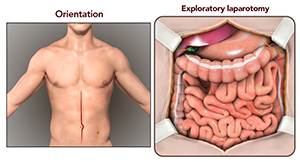Laparoscopy

Laparoscopy is a minimally invasive surgical procedure performed using a laparoscope, a thin fibre-optic instrument with a camera and lens attached to it. Laparoscopes can be used for diagnosing and treating various conditions.
Gynaecologic Laparoscopy
Laparoscopy in gynaecology is used to check for any abnormalities in the uterus, ovaries, fallopian tubes, and other organs which are not evident by other diagnostic procedures such as X-rays and other scans. Laparoscopy is used to diagnose and treat the conditions of pelvic pain, infertility, fibroids, cysts, tumours, endometriosis, ectopic (tubal) pregnancies, pelvic inflammatory disease, and other gynaecological problems.
Pelvic pain is a characteristic symptom of various gynaecological conditions. Assessing the exact cause for pain is essential to treat the condition. Laparoscopy helps in assessing the exact cause of the pain such as the presence of scar tissue, infections, ovarian cysts, gastrointestinal problems, urinary problems, musculoskeletal problems, and other conditions.
Procedure
During the procedure, the surgeon makes a small incision in the abdomen, usually at or below the belly button, and inserts a tube through which the laparoscope is introduced into the abdomen. The laparoscope helps in examining the pelvis and the images from the camera are projected onto a large screen for the surgeon to view. A special contrast dye may also be injected before the procedure for better visualisation of the fallopian tubes. After the procedure, the incisions are closed with stitches and covered with bandages.







